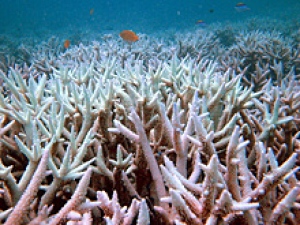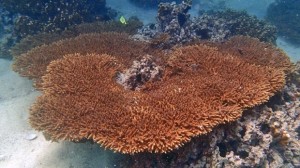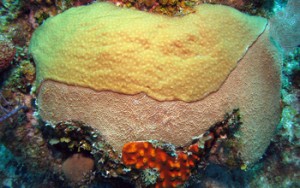http://www.cbc.ca/news/technology/algae-on-coral-in-uae-gives-hope-against-bleaching-1.2974647
Technology & Science
Persian Gulf algae prevents coral bleaching in seawater that can reach 36 Celsius in summer
CBC News Posted: Feb 27, 2015 5:00 AM ET Last Updated: Feb 27, 2015 5:00 AM ET
Algae living on coral in the Persian Gulf appear to protect the host coral from dying off. Seawater in the area gets so warm the same temperatures would kill off reefs elsewhere. (Jorg Wiedenmann, John Burt)
Scientists have discovered a new species of algae in the United Arab Emirates that helps corals survive in the warmest seawater temperatures on the planet.
Researchers from the University of Southampton and the New York University Abu Dhabi described the “heat-tolerant species” in a paper published this week in the journal Scientific Reports.
‘It gives hope to find that corals have more ways to adjust to stressful environmental conditions than we had previously thought.’- Jorg Wiedenmann, Coral Reef Laboratory at University of Southampton. Ocean waters in the Persian Gulf can reach temperatures of up to 36 degrees Celsius at the peak of summer — warm enough to kill off corals found anywhere else in the world.
How Gulf corals manage to thrive in such habitats likely has something to do with the nutrient-rich algae living in their tissue, the researchers believe.
It seems the algae living off Gulf corals in a symbiotic relationship give their coral hosts a heat-resistant edge not found in reefs elsewhere.
Climate change threat
“When analyzed by alternative molecular biological approaches, we found pronounced differences that set this heat-tolerant species clearly aside,” the researchers said in a statement.
In reference to its ability to survive unusually high temperatures, the researchers named the algae Symbiodinium thermophilum.

Higher water temperatures often cause corals to lose their colour and die, a phenomenon known as coral bleaching. (Ove Hoegh-Guldberg/Centre for Marine Studies/The University of Queensland)
Algae are known to deliver nutrition to the coral they inhabit. However, algae are also sensitive to environmental changes, with even slight increases in seawater temperatures putting them at risk.
Loss of algae on corals in the symbiotic relationship often results in “coral bleaching,” in which the white skeletons of corals are left exposed once their algae tissue thins or dies.
“In Gulf corals, both the coral host and the associated algal partners need to withstand the high seawater temperatures,” Jörg Wiedenmann, head of the Coral Reef Laboratory at the University of Southampton Ocean, said in a statement.
John Burt, with NYU Abu Dhabi, said the team confirmed the new type of algae is prevalent year-round across several dominant species found near the coast of Abu Dhabi, the capital of the UAE.
Wiedenmann said more research must be done to better understand how the Gulf’s coral reefs can withstand extreme temperatures, in order to get a better grasp of how reefs elsewhere are dying as a result of climate change.
“It gives hope to find that corals have more ways to adjust to stressful environmental conditions than we had previously thought,” Wiedenmann said. “However, it is not only heat that troubles coral reefs. Pollution and nutrient enrichment, overfishing and coastal development also represent severe threats to their survival.”

